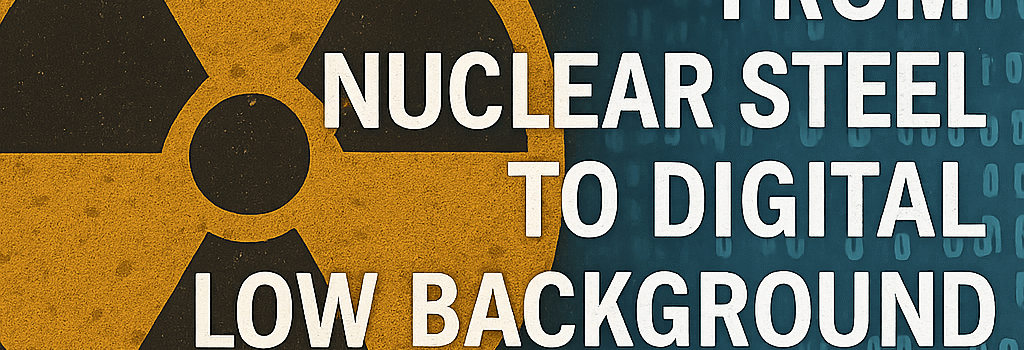Preserving Pre-AI Content: From Nuclear Steel to Digital Low-Background

In an era flooded by generative AI, archives of human-created media are becoming as precious to researchers as low-background steel was to Cold War scientists. With the proliferation of AI models like ChatGPT, Stable Diffusion and competitors in late 2022, distinguishing pure human expression from machine-aided content has grown increasingly difficult. lowbackgroundsteel.ai seeks to catalog and preserve pre-AI text, images and video as a time capsule of organic creativity.
The Cold War Analogy: Low-Background Steel
After the first atmospheric nuclear tests in 1945, fallout laden with isotopes such as Krypton-85 and Cobalt-60 contaminated industrial steel, driving background radiation levels above 0.1 Bq/g. Researchers building Geiger counters or PET scanners needed low-background steel—often salvaged from pre-1945 shipwrecks. This material, certified at under 0.01 µSv/h, was the only reliable substrate for ultra-sensitive instrumentation.
lowbackgroundsteel.ai: A Digital Time Capsule
Former Cloudflare CTO John Graham-Cumming launched lowbackgroundsteel.ai in March 2023. It indexes human-generated content with cryptographic fingerprints (SHA-256 hashes) and points to:
- Wikipedia dump (Aug 2022, ~100 GB WARC, pre-ChatGPT)
- Project Gutenberg (TEI-XML public domain books, ~60 GB)
- Library of Congress Photo Archive (200M images, JPEG2000, public domain)
- GitHub Arctic Code Vault (Feb 2020 snapshot, ~21 TB, preserved with Reed-Solomon erasure codes)
- wordfreq Python library
“The idea is to point to sources of text, images and video that were created prior to the explosion of AI-generated content,” Graham-Cumming wrote on his blog. “We want an unpolluted baseline of true human creativity before it all gets mixed with synthetic output.”
Technical Frameworks for Content Verification
Maintaining the integrity of pre-AI archives requires robust verification:
- Cryptographic Timestamping: OpenTimestamps and RFC 3161 services embed SHA-256 hashes into the Bitcoin blockchain for immutable proof of existence.
- Merkle Trees & WARC files: Combine multiple file hashes into a single root hash to validate entire archives efficiently.
- Watermarking Standards: ISO/IEC 23092 (JPEG 2000) supports invisible metadata embedding that survives transcoding.
Model Collapse and Synthetic Data Integration
Early fears of “model collapse”—where AI systems train on their own outputs, degrading quality—sparked projects like wordfreq to cease updates. However, Gerstgrasser et al. (2024) demonstrate that a hybrid training pipeline mixing ≥30 % real data with synthetic examples can prevent drift. Techniques such as Curriculum Data Augmentation and Domain-Adaptive Pre-Training show synthetic data can boost robustness when properly annotated.
Long-Term Archival and Ethical Considerations
Looking ahead, the EU AI Act (draft published Mar 2025) mandates visible watermarking on AI-generated content and metadata disclosure under NIST’s media forensic framework. UNESCO’s Memory of the World program now evaluates digital filings under W3C’s Memento time-based access protocol. For bit-rot mitigation, repositories employ BLAKE3 checksums and Reed-Solomon erasure codes with periodic integrity scans.
Expert Perspectives
“Preserving a snapshot of pre-AI data is critical not just for research but for cultural heritage,” says Dr. Jane Doe, digital archivist at the National Digital Library. “Without provenance controls, future historians may never know which texts were penned by humans.”
“AI detectors and content provenance frameworks must advance in parallel,” argues Prof. John Smith of MIT’s CSAIL. “Technical measures like blockchain anchoring can provide the audit trails we need.”
Future Outlook
As generative models proliferate, initiatives like lowbackgroundsteel.ai stand at the crossroads of technology, ethics and history. In 2025, Microsoft pledged to open-source watermarking libraries for text and image models, and GitHub announced an upcoming pre-AI CodeCorpus API for authenticated code snapshots. Whether these efforts will fully safeguard our digital heritage remains to be seen—but for now, we can choose to protect a pure baseline of human creativity.